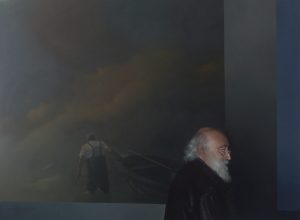
Organiza:
MUBAG
Lugar:
Planta baja del MUBAG
Fechas
Desde el 2 de noviembre de 2022
UNA AMISTAD
Entre los cuadros del pintor Javier Lorenzo que he tenido ocasión de ver, Espectador de las estaciones es, para mi gusto, uno de los más inquietantes. Se trata de un retrato del también pintor Vicente Rodes, quien fuera amigo de Lorenzo durante muchos años, una amistad que se prolongó hasta la muerte de este último, ocurrida meses atrás. Esta inclinación llevó a que Lorenzo pintara a Rodes en diversas ocasiones: unas veces, lo hizo de cuerpo entero; otras, de espaldas, caminando junto a unos amigos; en una de las obras, Rodes observa con interés un cuadro donde aparece él mismo retratado: pintura de la pintura, que nos interroga sobre el misterio de la representación.
Vicente Rodes y Javier Lorenzo se conocen en Alicante, sobre la segunda mitad de los años 70, cuando coinciden en las exposiciones o en las tertulias de la Galería 11, que dirigía Carmen Cazaña. En aquel momento, está de moda la pintura abstracta que es el género que ambos practican; también les gustan los mismos pintores: Rothko, De Kooning… Rodes permanecerá fiel a la abstracción durante toda su vida; Lorenzo, unos años después, se inclinará por la figuración. Este cambio de tendencia no afectará a la relación que mantienen los amigos: lo que les une –al margen de algunas aficiones mundanas que comparten– es su fervor por la pintura y la sinceridad frente a la obra del otro. Al hablar de la amistad, Séneca nos dice que ésta debe ser desinteresada. Si un interés movió a Javier Lorenzo y Vicente Rodes fue la pintura: dos pintores que aman la pintura, si saben ser generosos, lo tienen todo para entenderse.
Afirmar que Espectador de las estaciones es un retrato quizá no sea del todo cierto. En la tela, Rodes dispone de un espacio muy reducido; la mayor parte de la superficie del cuadro está ocupada por unas masas de nubes de color amarillento y azulado, enmarcadas entre dos amplias franjas rectangulares: una, vertical, de tonos grises, y otra, horizontal, de color azul. El juego de colores de las nubes y las luces, realzado por las veladuras, crea un espacio neblinoso, inquietante. Caminando en dirección a ese espacio, vemos a un hombre fornido que arrastra una barca vacía. Debe de estar próximo a la orilla porque el agua apenas le alcanza a cubrir las rodillas. ¿Quién es este hombre del que no vemos su rostro, ni sabemos hacia dónde se dirige? ¿Podría ser Caronte y hallarnos frente a la laguna Estigia? Lo cierto es que no lo sabemos: todo son cavilaciones que cada espectador resolverá a su manera. Mientras tanto, en el ángulo inferior derecho, un Vicente Rodes indiferente parece a punto de abandonar el cuadro. La luz que baña su cabeza, distinta a la que envuelve al hombre que tira de la barca, crea dos realidades, dos tiempos, dos espacios: el de la imaginación y el de la pintura.
José Ramón Giner
A FRIENDSHIP
Among the paintings by Javier Lorenzo that I have had the opportunity to see, Spectator of the Seasons is, to my personal taste, one of the most disturbing. It is a portrait of the painter Vicente Rodes, who was Lorenzo’s friend for many years, a friendship that lasted until the latter’s death a few months earlier. This inclination led Lorenzo to paint Rodes on several occasions: sometimes he painted him full-length, other times from behind, walking with friends; in one of the works, Rodes looks with interest at a painting in which he himself is portrayed: a painting of painting, which interrogates us about the mystery of representation.
Vicente Rodes and Javier Lorenzo met in Alicante in the second half of the 1970s, when they coincided in exhibitions or gatherings at Galeria 11, which was run by Carmen Cazaña. At the time, abstract painting was in vogue, which is the genre they both practised; they also liked the same painters: Rothko, De Kooning…Rodes would remain faithful to abstraction throughout his life; Lorenzo, a few years later, would lean towards figuration. This change of tendency will not affect the relationship between the friends: what unites them – apart from some wordly hobbies they share- is their fervour for painting and their sincerity towards each other’s work. When speaking of friendship, Seneca tells us that it must be disinterested. If there is one interest that moved Javier Lorenzo and Vicente Rodes, it was painting: two painters, if they know how to be generous, have everything they need to understand each other.
Saying that Spectator of the Seasons is a portrait perhaps is not entirely true. Rodes has very little space on the canvas; most of the painting’s surface is occupied by masses of yellowish and bluish clouds, framed between two wide rectangular bands: one vertical, grey, and the other horizontal, blue. The play of colours of the clouds and the lights, enhanced by the glazes, creates a misty, unsettling space. Walking in the direction of this space, we see a stout man dragging an empty boat. He must be close to the shore because the water barely covers his knees. Who is this man whose face we cannot see, nor do we know where he is going? Could he be Charon and we are in front of the Styx Lagoon? The truth is that we don’t know: these are all musings that each spectator will resolve in their own way. Meanwhile, in the lower right-hand corner, an indifferent Vicente Rodes seems about to leave the painting. The light bathing his head, different from the one that envolves the man pulling the boat, creates two realities, two times, two spaces: that of the imagination and that of the painting.
José Ramón Giner


